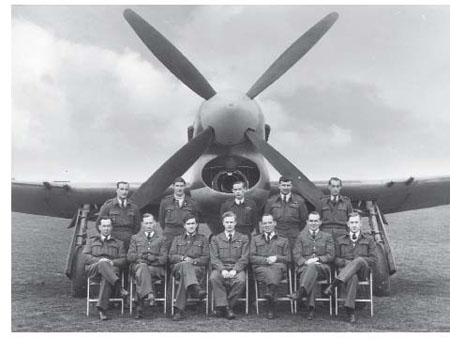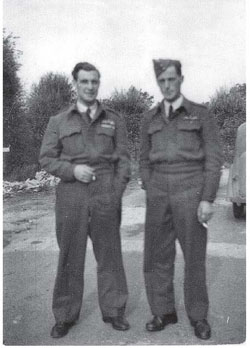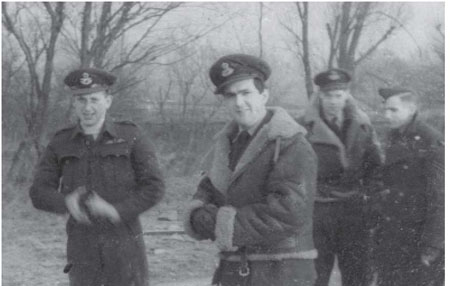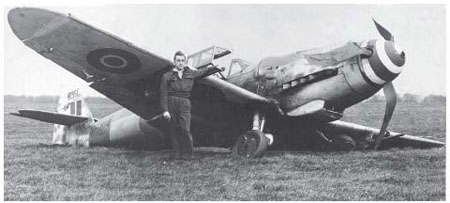A Very Unusual Air War (42 page)
Read A Very Unusual Air War Online
Authors: Gill Griffin

5 October
: This was my first flight in the Messerschmidt 109G, known as the Gustav, the most advanced model of the 109 at that time. It was superior in many respects to the Spitfire Mk V, many of which were still in service, but the Griffon Spitfires (Mks XII and XIV) and the Mustang III all outclassed the Gustav. Used by the Luftwaffe in its dive and zoom tactics, the Gustav was still a formidable opponent. I did not like flying the 109; for me the cockpit was cramped and, with its up-and-over canopy, claustrophobic.
10 October
: Further experience on type. As I was flying without an escort, I stayed close to base. With its narrow undercarriage, great care had to be taken when taxiing.
24 October
: This aircraft would have been the Tempest V with a Napier Sabre liquid-cooled engine. Like the Typhoon, the Tempest picked up speed very quickly in a dive and great care was necessary in the recovery.
31 October
: What a week! I came to hate this experimental bombing; high-level flight starting at 15,000 feet, releasing at 12,000 feet and dive bombing starting at 8,000 feet to low level, ending with cannon firing for ground attack.
| Summary for:– October 1944 | 1. Spitfire | 12–20 |
| Unit:– AFDU Wittering | 2. Mustang | −40 |
| Date:– 1/11/44 | 3. ME 109G | 1–00 |
| Signature:– H.L. Thorne F/Lt | 4. Tempest | −35 |
| | ||
| T.S. Wade S/Ldr O/C Flying AFDU |
| YEAR | 1944 | AIRCRAFT | Pilot or 1st Pilot | 2nd Pilot, Pupil or Pass. | DUTY (Including Results and Remarks) | Flying Time | Passenger | ||
| MONTH | DATE | Type | No. | Dual | Solo | ||||
| November | 1st | Spitfire IX | JL359 | Self | | Guns and camera | | −55 | |
| | 2nd | Spitfire IX | MJ421 | Self | | Bombing | | −25 | |
| | | Spitfire IX | MJ421 | Self | | Bombing | | −40 | |
| | 4th | Spitfire IX | MJ421 | Self | | Bombing | | −25 | |
| | 5th | Spitfire XVI | DV295 | Self | | Speed runs | | −40 | |
| | 6th | Spitfire IX | MJ421 | Self | | Bombing | | −30 | |
| | | Spitfire IX | MJ421 | Self | | Bombing | | 1–00 | |
| | 9th | Hurricane | 397 | Self | | Photography | | −20 | |
| | 10th | Mustang III | FZ107 | Self | | To Manston | | −45 | |
| | | Meteor I | K | Self | | Local experience on type | | −30 | |
| | | Anson | 184 | F/Lt Lane | Self | To base | | 1–35 | |
| | 13th | Spitfire XVI | PV295 | Self | | Speed run | | −15 | |
| | 14th | Spitfire XVI | PV295 | Self | | To Grimsburgen, Brussels | | 1–55 | |
| | 15th | Spitfire XVI | PV295 | Self | | Grimsburgen to Antwerp | | −15 | |
| | 18th | Spitfire XVI | PV295 | Self | | Antwerp to Wittering | | 1–40 | |
| | 20th | ME 109G | TP814 | Self | | Air test | | −10 | |
| | 22nd | ME 109G | TP814 | Self | | Crashed on take-off | | −05 | |
| | | Spitfire IX | MJ421 | Self | | Weather test | | −25 | |
| | | Spitfire 21 | LA201 | Self | | Preliminary handling | | −30 | |
| | 27th | Spitfire IX | MJ421 | Self | | Marker bombing | | −25 | |
| | 30th | Spitfire IX | PV295 | Self | | Observe Lancaster marker bombs | | −45 | |
| | | | | | | GRAND TOTAL TO DATE 1,103 hours 30 mins | 3–30 | 11–20 | |
| | | | | | | | 60–00 | 1028–40 | 16.15 |




5 November
: With increased production of Spitfires and Merlin-engined Mustangs, demand for Merlins and Griffons outstripped Rolls-Royce production capacity. The American car firms Packard and Ford produced Merlins under licence. The Spitfire Mk XVI was powered by a Packard Merlin and had American armament of .5 mm Browning machine guns instead of 20 mm Hispano cannons. Broadly similar to the Spitfire Mk IX, it was still checked for performance.

F/Lt Thorne and his ME109 at Wittering, 22nd November 1944. Port oleo collapsed on take off.
10 November
: For a few hours I was attached to the famous 616 Squadron, which had also been known as ‘Bader’s Bus Company’ earlier in the war. Written on the Squadron bulletin board during 1941 was ‘Bader’s Bus Company – daily tickets to the Continent – Return tickets only!’
That autumn the Luftwaffe brought their first jet-engined fighter, the ME262, into service. It was an outstanding aircraft capable of speeds far in excess of any piston-engined machine. It was imperative to get the RAF jet into service for operational and prestige purposes. The first Gloster Meteors underwent handling trials at A&AAE, Boscombe Down, and were immediately passed into service with ‘A’ Flight, 616 Squadron.
Flying our first jet was a revelation, no torque, therefore no swing on take-off, no vibration and little or no engine noise. The engines of the Meteor Mk I had very poor performance at low speed, so take-off procedure was very different. Brakes held full on, throttle fully open; when maximum revs had built up, release brakes and allow the aircraft to roll forward. When speed built up, stick back to raise nose wheel, followed by becoming airborne. Maintain level flight until speed built up to 200 mph, then commence climb. In other respects the Meteor was an easy aeroplane to fly, with excellent forward visibility.
14 November
: This was a flight and landing in mainland Europe. After D-Day increasing numbers of enemy aircraft fell into Allied hands as the ground forces advanced towards Germany. I was sent over to test fly a number of ME109s which were intended to be ‘playthings’ for senior officers. Great care was needed, as many of these machines were booby-trapped. My flight had to be planned with care, as some of the Channel ports, including Calais, Cherbourg and Dunquerque, had been bypassed but still held enough ammunition to give a hot reception to any Allied aircraft that flew too close. It had been a very wet autumn and the steel mesh decking (Somerfield Tracking), which made the runways, was underwater. Landing and take-offs left wakes rather like speedboats. Conditions were primitive and I spent 2 or 3 nights in partially destroyed buildings around the airfield perimeter; the least damaged had been made into temporary living quarters and messes. The Wehrmacht forces had been pushed back to the River Scheldt but small groups, known as Werewolves, were active at night.
